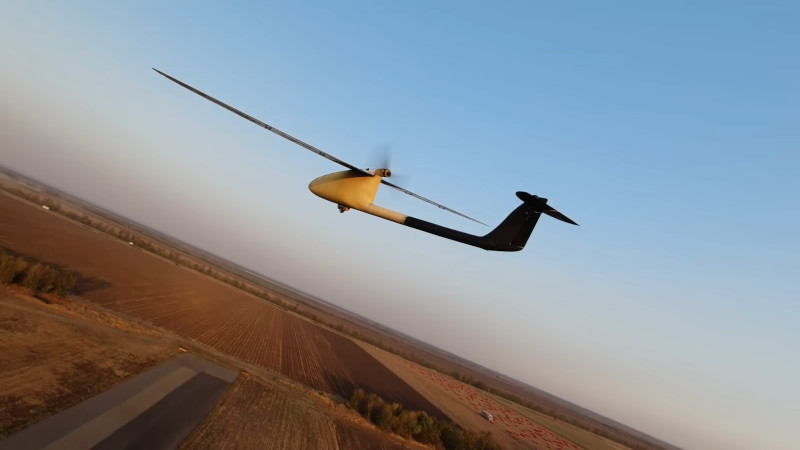The RC world was changed forever by the development of the lithium-polymer battery. No longer did models have to rely on expensive, complicated combustion engines for good performance. However, batteries still lack the energy density of other fuels, and so flying times can be limited. Aiming to build a drone with impressively long endurance, [Игорь Негода] instead turned to hydrogen power.

With a wingspan of five meters, and similar length, the build is necessarily large in order to carry the hydrogen tank and fuel cell that will eventually propel the plane, which uses a conventional brushless motor for propulsion. Weighing in at 6 kilograms, plenty of wing is needed to carry the heavy components aloft. Capable of putting out a maximum of 200W for many hours at a time, the team plans to use a booster battery to supply extra power for short bursts, such as during takeoff. Thus far, the plane has flown successfully on battery power, with work ongoing to solve handling issues and determine whether the platform can successfully fly on such low power.
We’re eager to see how the project develops, particularly in regards to loiter time. We can imagine having a few pilots on hand may be necessary with such a long flight time planned — other drones of similar design have already surpassed the 60-minute mark. Video after the break.
















For something that is supposed to have a high loiter, it sure has tiny wings. And an overly flat airfoil?
The tiniest of wheels would spare the boom wear on takeoff.
Some concern about how they complain about its speed upwind vs downwind, as though they don’t understand that it flies relative to the air mass. But that may be due to the translation.
An impressive amount of work.
I do wonder if the hydrogen is worth the trouble though. That 6 kg of hydrogen, bottle, fuel cell and plumbing stores around 6 kWh of energy. After the fuel cell and converter efficiency you get, what, 2 kWh? 10 hours at their 200W burn rate?
What can you get from just a 6 kg pile of li-poly cells? 1.2 kWh?
That’s about 2 square meters of wing. What does 2 square meters (i.e., ~200 watts) of solar cells weigh?
Yep. Hydrogen is evil. Batteries are much better and if you really want a long range plane then go ICE way. https://en.wikipedia.org/wiki/The_Spirit_of_Butts%27_Farm
Or use a methanol fuel cell.
https://en.wikipedia.org/wiki/Direct_methanol_fuel_cell
Kinda thin on the ground, those. Can you actually buy one?
Specs from the EFOY model 2400: 110 watts, 9 kg, gobbles 0.9 kg/kWh of methanol.
For reference, the Yamaha EF1000iS generator ($900) is 12.7 kg (including fuel tank, muffler, inverter and pretty case), puts out 900 watts, and sips 0.48 kg/kWh of gasoline.
Well yes, you probably have to wait a bit more till they are more efficient, if you want more power. I also don’t know anyone who owns one. But I believe eventually the fuel cell group will move in that direction, as handling methanol is way easier and safer than hydrogen.
So for now OP is right with “and if you really want a long range plane then go ICE way.” I just wanted to point out, that there are alternatives to the hydrogen fuel cell coming or are already there, if you do not need too much power output
My company developed alcohol fuel cells for a uav contract a few years back. We ran into the hydrogen mental block on reason. They were unwilling to sacrifice anything because of a 3% efficiency difference and in the end couldn’t make a hydrogen system work. We were talking about producing small charging cells for camping etc.
And unless the translation is worse than I thought they don’t seem to have adequate tail volumes and have no clue how a high thrust line , and prop wash over empenage makes for a unstable flight. When you have high energy air flow over controls power changes can essentially have the effect of the tail surfaces making more or less lift. The comments about how the nose drops show his lack of understanding. There have been a few designs with this layout and while they can fly they never end up flying well. The real bad ones have quirks like having to pull the power right off just to rotate and takeoff.
Maybe they should use an extension cord for extra power during take-off. No seriously, a thin cord coiled properly on the runway and plugged into the glider could provide a power boost and when the glider takes off have a sensor release the cord. All the power at take off, none of the weight. (Or if the take off roll is similar for each take off just have a cord that pulls out when the glider lifts off.)
If all you get out of this is a launch assist, skip the complexity of an electrical connection and just use what other RC glider pilots use: a Hi Start or bungee. Or if you’re flush, a winch.
Well I suppose it would keep the battery at 100% but yea, a bungee is probably a better idea.
Really? A camera for reading a power meter? That is ridiculous. Transmitting some meter readings doesn’t need a camera. Do they know what energy the camera alone is taking?
“if it’s stupid but it works, it isn’t stupid.”
It’s a fine solution.
Why put effort and time into building, debugging, calibrating, etc. a custom solution when just planting a camera there will give you the data you want? Be smart. Go do something more important with your time.
What? Doh!!! They already have a plethora of off the shelf hardware telemetry systems that are far more economical in every way imaginable than that of a camera link transmitting even digital video of power meter. Hydrogen cell is pretty damn cutting edge high tech stuff, these guys are so lame as to overlook many design flaws within their flight systems and their goals of the complete system as a whole?
I understand proof of concept isn’t always so eloquent and that sometimes duct tape and superglue does in fact go a long way but come-on now!
What in the world are you talking bout Willis?
Agreed
“No longer did models have to rely on expensive, complicated combustion engines”
What now?